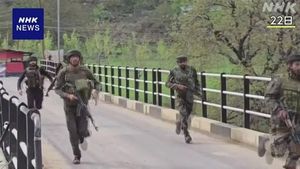On April 30, 2025, a significant sinkhole incident occurred in Gangdong-gu, Seoul, causing local authorities to take immediate action. The sinkhole, which measured approximately 2.5 meters in length, 3.0 meters in width, and 1.2 meters in depth, was reported at 3:24 PM near the Gildeong intersection, specifically on the road leading towards Dunchon-dong. Fortunately, no casualties were reported as a result of this incident.
The cause of the sinkhole has been traced back to a leak from a 100mm joint connected to a larger 2000mm water supply pipe. A spokesperson from the Gangdong-gu office explained, "The leak was due to a failure in the water drainage system, which led to ground subsidence." The local water authority, the Gangdong Waterworks Office, quickly responded by closing off two lanes of traffic to facilitate repair work.
As recovery efforts commenced, city officials projected that the work would be completed by 11 PM the same day. The area surrounding the sinkhole was cordoned off to ensure public safety while repairs were underway. The city has emphasized that they acted swiftly to prevent any injuries or further incidents, stating, "We were able to respond immediately upon receiving the report, ensuring that there were no human casualties."
In light of this incident, the Gangdong-gu district has announced that it will conduct an emergency inspection of underground voids across its jurisdiction, starting on May 2, 2025. This inspection is a collaborative effort with the Seoul city government, aimed at addressing residents' concerns over the increasing frequency of ground subsidence events in the area.
To carry out this inspection, authorities will employ ground penetrating radar (GPR) technology, which allows for precise analysis of underground structures without the need for invasive digging. The initial phase will involve a vehicle-mounted GPR system to scan the roads comprehensively. If any anomalies are detected, further evaluations will be conducted using endoscopic cameras to assess the size and condition of any underground voids.
Lee Su-hee, the head of Gangdong-gu, expressed the urgency of these inspections, saying, "Residents are understandably anxious due to the repeated occurrences of ground subsidence. We are committed to thoroughly examining all roads in the district and taking any necessary actions promptly." This proactive approach aims to reassure the community and enhance safety measures in the face of potential geological issues.
The situation in Gangdong-gu is part of a broader concern regarding urban infrastructure and geological stability in major cities. As urban areas continue to expand, the integrity of underground utilities and the ground itself can be compromised, leading to incidents like this sinkhole. Experts suggest that cities need to invest in regular maintenance and modern technology to monitor and manage these risks effectively.
As the investigation unfolds and recovery efforts are completed, residents are encouraged to stay informed through the city's safety portal, where updates and findings from the GPR inspections will be published. The city has committed to transparency in sharing information regarding the stability of the roads and any potential hazards that may arise in the future.
In conclusion, the sinkhole incident in Gangdong-gu serves as a reminder of the importance of infrastructure maintenance and the need for ongoing vigilance in urban planning. As the city continues to address the immediate concerns, the upcoming inspections will play a crucial role in ensuring the safety and confidence of residents in their community.




